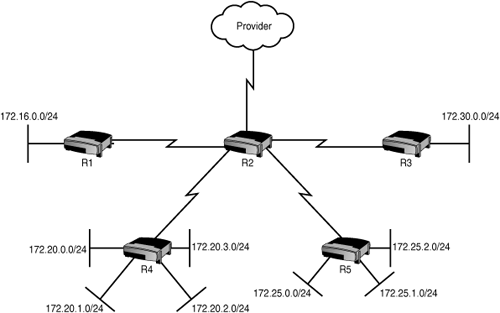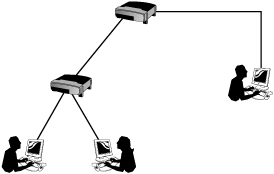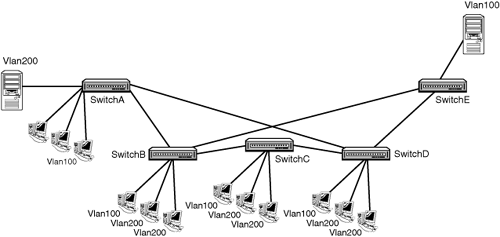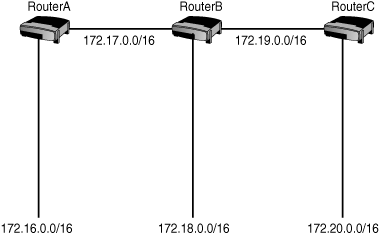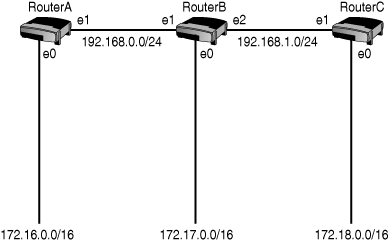If you are reading this, you likely feel ready to tackle the CCNA exam and need to assess your skills to see if you can spot any weaknesses. As you take this practice exam, the authors recommend the following test taking tips:
Read each question twice—. There is a big difference between reading a question that you think reads, “Which of the following are true,” but really reads, “Which of the following are not true.” Be sure to read each question carefully so that you can fully understand the question.
Read the answers starting from the bottom—. When you read the answers from the bottom, you force yourself to carefully read each answer. If you read the answers from the top, you might find yourself quickly selecting an answer that looks vaguely right and skipping over the other answers that might have been a better answer.
Time yourself—. The CCNA exam is a 90-minute exam. Time yourself during this practice exam to make sure that you stay within this time limit.
If you do not know the answer to a question, make a note of it—. Go back and review any trouble areas later. You should be interested not only in finding the answer to the question, but also in mastering that particular topic in its entirety. If you are unsure about one aspect of a topic, chances are you might be unsure about other areas related to that same topic.
Mentally get yourself in the frame of mind to take a test—. To properly assess yourself, take this practice exam as you would take the real exam. This means that you should find yourself a quiet place without any distractions so that you can focus on each question. (Yes, that includes turning off the television.) You can have some scratch paper to write on, but calculators are not allowed on the real exam, so do not use them on the practice exam.
If you cannot determine the correct answers, begin eliminating the incorrect answers—. If there are four options and you know that three are absolutely wrong, the fourth option has to be the correct one.
Continue taking this practice exam until you get a perfect score—. When you can consistently score high on these practice exams, you are ready to take the real exam.
Don’t despair—. Should you not do so well on the practice exam, do not worry. It only means that you need to continue studying. Be glad that you are able to spot your weak areas now and not after taking the real exam. Go back through and review your problem areas.
We wish you the best of luck in your pursuit of the coveted CCNA certification.
You need to assign an IP address on a router for a new Ethernet network. You need to assign the router to the first IP address on the second useable subnet taken from the major Class C network of 192.168.25.0/24. The subnet must support at least 13 hosts on each subnet, but you must allow for as many subnets as possible. In addition, the router has been configured with the | |||||||||||
You have been asked to troubleshoot a NAT configuration for the network shown in the figure. Another engineer has entered the following configuration into the router: access-list 4 permit 172.21.248.0 0.0.1.255
ip nat pool NATPOOL 192.168.191.66 192.168.191.70 netmask
255.255.255.248
ip nat inside source list 4 pool NATPOOL
!
interface serial 1/0
ip address 192.168.191.65 255.255.255.248
ip nat oustide
!
interface fastethernet 0/3
ip address 172.21.254.1 255.255.254.0
ip nat inside
!There is a problem with this configuration: Not all users are able to access the Internet. What is wrong with the configuration that causes this problem?
| |||||||||||
What type of attack involves a flooding of SYN packets to open TCP sessions to a server? | |||||||||||
Which of the following is used to identify a wireless network? | |||||||||||
Examine the following output. Which line below is most responsible for a trunk not forming on FastEthernet0/1? Switch#show interfaces fastethernet0/1 switchport Name: Fa0/1 Switchport:Enabled Administrative Mode: static access Operational Mode: static access Administrative Trunking Encapsulation: dot1q Operational Trunking Encapsulation: native Negotiation of Trunking: Off Access Mode VLAN: 1 (default) Voice VLAN: none Administrative private-vlan host-association: none Administrative private-vlan mapping: none Operational private-vlan: none Trunking VLANs Enabled: ALL Pruning VLANs Enabled: 2-1001 Capture Mode Disabled Capture VLANs Allowed: ALL Protected: false Voice VLAN: none (inactive) Appliance trust: none Switch#show running-config <<output omitted>> interface FastEthernet0/1 no ip address duplex full speed auto | |||||||||||
Which of the following routed protocols does EIGRP support? | |||||||||||
Your boss has asked you to secure your Telnet sessions on your routers. What is the correct configuration to allow only two Telnet sessions to run at a time with an encrypted password of | |||||||||||
Examine the figure shown. OSPF is running on RouterA, RouterB, RouterC, and RouterD. RIP is running on RouterD and RouterE. Based on the figure, which path will RouterA take to get to RouterD? | |||||||||||
Which of the following is a valid host IP address? Select all that apply. | |||||||||||
What would be the correct syntax to create and apply an access list inbound on fastethernet 0/0 that would allow all hosts on the 172.19.40.0/21 network Telnet access to a server with the IP address 10.0.0.55?
| |||||||||||
You are working on a router that does not have any loopback interfaces. Without the presence of a loopback interface, how do you choose the Router ID in OSPF?
| |||||||||||
Examine the figure that follows. You want to reduce the size of your routing table on R2. Which of the following is an example of a route summary that represents the local area networks on R4? | |||||||||||
Which of the following information is included with the | |||||||||||
You try to create a VLAN that is automatically propagated out to all other switches. The switch allows you to create the VLAN, but it is not propagated to other switches. You execute the Switch> show vtp status
VTP Version : 2
Configuration Revision : 0
Maximum VLANs supported locally: 250
Number of existing VLANs : 15
VTP Operating Mode : Transparent
VTP Domain Name :
VTP Pruning Mode : Disabled
VTP V2 Mode : Disabled
VTP Traps Generation : Disabled
MD5 digest : 0xBF 0x84 0x94 0x33 0xFC 0xAF 0xB5 0x70
Configuration last modified by 0.0.0.0 at 0-0-00 00:00:00 | |||||||||||
How many broadcast domains are there in the figure shown? | |||||||||||
Examine the figure shown. Your computer has the IP address 172.16.64.201/22, and you try to access a website on the web server with the IP address 172.16.129.48/22. Unfortunately, you are unable to access the site. Below are the partial configurations on RouterA and RouterB: RouterA interface fastethernet3/1 ip address 172.16.64.1 255.255.252.0 interface serial0/0 ip address 172.16.22.190 255.255.255.252.0 ip route 172.16.128.0 255.255.252.0 172.16.24.185 RouterB interface fastethernet0/0 ip address 172.16.128.1 255.255.252.0 interface serial0/0 ip address 172.16.24.185 255.255.252.0 ip route 172.16.64.0 255.255.252.0 172.16.22.190 Why are you unable to access the website? | |||||||||||
Examine the figure that follows. There is a significant amount of traffic between the workstations and the server on VLAN200. Which switch would be the best choice as the root switch for VLAN 200? | |||||||||||
Examine the figure. You are running EIGRP on all routers, but you are unable to route to all networks in the diagram. You have narrowed the problem down to RouterB. Below is the EIGRP configuration for RouterB. RouterB(config)#router eigrp 1 RouterB(config-router)#network 192.168.206.16 RouterB(config-router)#network 192.168.0.96 RouterB(config-router)#network 192.168.0.64 What is wrong with this configuration that causes this problem? | |||||||||||
Examine the following output. What does the highlighted portion refer to? Router#show ip protocols
Routing Protocol is "eigrp 1"
Outgoing update filter list for all interfaces is not set
Incoming update filter list for all interfaces is not set
Default networks flagged in outgoing updates
Default networks accepted from incoming updates
EIGRP metric weight K1=1, K2=0, K3=1, K4=0, K5=0
EIGRP maximum hopcount 100
EIGRP maximum metric variance 2
Redistributing: eigrp 1
EIGRP NSF-aware route hold timer is 240s
Automatic network summarization is not in effect
Maximum path: 3
Routing for Networks:
10.0.0.0/8
172.16.0.0/16
172.17.0.0/16
Routing Information Sources:
Gateway Distance Last Update
172.16.1.1 90 00:15:12
172.17.0.1 90 00:15:10
Distance: internal 90 external 170 | |||||||||||
You have the public range of 2.2.2.0/25 from your ISP. You want to subnet this further to create a public address pool of six addresses that you are going to use to NAT your inside local addresses. Which of the following configurations allow you to NAT your inside local addresses of 192.168.14.0/24 to a pool of six addresses taken from the 2.2.2.0/25 subnet?
| |||||||||||
Examine the figure. You are running frame-relay between two routers. When you check the status of the interface on RouterA, it shows that the interface is up, but the line protocol is down. What is wrong? | |||||||||||
Ping and Traceroute operate at what layer of the OSI model? | |||||||||||
The output of the Router#show ip route
CODES: C - CONNECTED, S - STATIC, I - IGRP, R - RIP, M - MOBILE, B - BGP
D - EIGRP, EX - EIGRP EXTERNAL, O - OSPF, IA - OSPF INTER AREA
N1 - OSPF NSSA EXTERNAL TYPE 1, N2 - OSPF NSSA EXTERNAL TYPE 2
E1 - OSPF EXTERNAL TYPE 1, E2 - OSPF EXTERNAL TYPE 2, E - EGP
I - IS-IS, L1 - IS-IS LEVEL-1, L2 - IS-IS LEVEL-2, * - CANDIDATE
DEFAULT
U - PER-USER STATIC ROUTE, O - ODR
GATEWAY OF LAST RESORT IS NOT SET
D 172.16.0.0 [90/2195456] VIA 10.16.10.1, 00:09:45, SERIAL0
D 172.31.1.0 [90/2681856] VIA 192.168.10.5 00:01:55, SERIAL1
C 10.0.0.0 IS DIRECTLY CONNECTED, SERIAL0
C 192.168.10.0 IS DIRECTLY CONNECTED, SERIAL1 | |||||||||||
Which of the following are true statements about the following command? (Select all that apply) ip route 192.168.1.0 255.255.255.0 10.1.24.1 | |||||||||||
In OSPF, what is the cost of a T1? | |||||||||||
What is a common subnet mask on point-to-point wide-area network links that would allow only two valid IP addresses? | |||||||||||
Which of the following commands configures a default gateway address on a switch? | |||||||||||
What is the maximum hop count for EIGRP? | |||||||||||
What is happening in the spanning-tree learning state? | |||||||||||
What type of cable would you use between a router and a switch? | |||||||||||
You type the following configuration into a router. When you execute the router rip network 10.0.0.0 network 172.19.0.0 version 2 interface serial 0/0 ip address 10.0.0.1 255.0.0.0 frame-relay map ip 10.0.0.2 100 frame-relay interface-dlci 100 no frame-relay inverse-arp interface ethernet 0/0 ip address 172.19.0.1 255.255.0.0 | |||||||||||
What is used in factoring the routing metric used by EIGRP? Select all that apply. | |||||||||||
CHAP can be described as what type of authentication? | |||||||||||
What does the following access control list do? Router(config)#ip access-list extended QueACL Router(config-ext-nacl)#permit tcp 172.30.31.192 0.0.0.15 10.0.4.0 0.0.3.255 eq 110 Router(config-ext-nacl)#permit tcp 172.30.31.192 0.0.0.15 10.0.4.0 0.0.3.255 eq 25 Router(config-ext-nacl)#interface fastethernet0/0 Router(config-if)#ip access-group QueACL in | |||||||||||
What type of cable should you use between two switches? | |||||||||||
Routing occurs at what layer of the TCP/IP model? | |||||||||||
Where is the feasible successor route stored in EIGRP? | |||||||||||
Which of the following addresses are on the same network as the host with an IP address of 192.168.6.81/29? Select all that apply. | |||||||||||
On what type of networks would you elect a DR? Select all that apply. | |||||||||||
What type of cable would you plug into a T1 interface with a built-in CSU/DSU? | |||||||||||
Which of the following is used to identify traffic from different VLANs? | |||||||||||
In the following configuration, what does the number Router eigrp 2 network 192.168.100.0 network 172.16.0.0 | |||||||||||
Which of the following commands would correctly configure Telnet access for three VTY lines and encrypt both the enable and Telnet passwords? | |||||||||||
Which of the following are mechanisms that distance vector routing protocols use to prevent loops? Select all that apply. | |||||||||||
You have a Class B network that you want to subnet to create at least 1,000 networks with as many hosts as possible on each subnet. What subnet mask should you use? | |||||||||||
Examine the figure. You want to configure an access list that would permit everyone on the 172.16.0.0/16 network to access resources on the 172.18.0.0/16 network but deny everyone else. You configure the following access-list: access-list 1 permit 172.16.0.0 0.0.255.255On what router and in what direction should you apply this access list? | |||||||||||
What is the broadcast address for the 172.19.48.0/21 network? | |||||||||||
What is the benefit to having a hierarchical design with OSPF? Select all that apply. | |||||||||||
In spanning-tree, how long does it take a port to go from the blocking state to the forwarding state? | |||||||||||
What device would you use to create more collision domains on your network? | |||||||||||
Which command shows you the current IOS that is in use on a router? | |||||||||||
Examine the figure. RIP is configured between RouterA, RouterB, and RouterC; however, you are unable to ping the 172.20.0.0/16 network from RouterA. The configurations of the routers are as follows: RouterA router rip network 172.16.0.0 network 172.17.0.0 RouterB router rip network 172.18.0.0 network 172.19.0.0 RouterC router rip network 172.19.0.0 network 172.20.0.0 What is wrong with the configuration that causes this problem? | |||||||||||
Below is the output of the RouterA Serial 0 is up, line protocol is down Hardware is MCI Serial Internet address is 192.168.15.170, subnet mask is 255.255.255.0 MTU 1500 bytes, BW 1544 Kbit, DLY 20000 usec, rely 255/255, load 1/255 Encapsulation HDLC, loopback not set, keepalive set (10 sec) Last in put 0:00:08, output 0:00:00, output hang never Output queue 0/40, 0 drops; input queue 0/75, 0 drops Five minute input rate 0 bits/sec, 0 packets/sec Five minute output rate 0 bits/sec, 0 packets/sec 8192 packets input, 141256 bytes, 0 no buffer Received 5125 broadcasts, 0 runts, 0 giants 4 input errors, 0 CRC, 0 frame, 0 overrun, 0 ignored, 3 abort 1 carrier transitions 21351 packets output, 1531572 bytes, 0 underruns 0 output errors, 0 collisions, 2 interface resets, 0 restarts RouterB Serial0/0 is up, line protocol is down Hardware is PowerQUICC Serial Internet address is 192.168.15.170/24 MTU 1500 bytes, BW 1544 Kbit, DLY 20000 usec, reliability 255/255, txload 1/255, rxload 1/255 Encapsulation PPP, loopback not set Keepalive set (10 sec) LCP Closed Closed: IPXCP Listen: CCP Open: IPCP, CDPCP Last input 00:00:00, output 00:00:00, output hang never Output queue 0/40, 0 drops; input queue 0/75, 0 drops Five minute input rate 0 bits/sec, 0 packets/sec Five minute output rate 0 bits/sec, 0 packets/sec 2251 packets input, 13515 bytes, 0 no buffer Received 61367 broadcasts, 0 runts, 0 giants 8 input errors, 0 CRC, 0 frame, 0 overrun, 0 ignored, 2 abort 2 carrier transitions 23515 packets output, 89234 bytes, 0 underruns 0 output errors, 0 collisions, 2 interface resets, 0 restarts | |||||||||||
What is wrong with the following OSPF configuration that causes this problem? Router ospf 65535 network 192.168.0.4 255.255.255.252 area 0 network 192.168.0.8 255.255.255.248 area 1 interface fastethernet 0/0 ip address 192.168.0.9 255.255.255.248 interface serial 0/0 ip address 192.168.0.5 255.255.255.252 | |||||||||||
Given the following output, how were the hosts learned on the router? Router# show hosts
Default domain is Que
Name/address lookup uses domain service
Name servers are 255.255.255.255
Host Flag Age Type
Address(es)
RouterA (perm, OK) 0 IP 192.168.100.1
RouterB (perm, OK) 0 IP 192.168.200.1 | |||||||||||
On what type of device would you typically configure the clock rate? | |||||||||||
CDP is found at what layer of the OSI model? | |||||||||||
Which of the following are methods to secure your Telnet access on a router? Select all that apply. | |||||||||||
What would cause an OSPF adjacency not to form between two routers? Select all that apply. |


